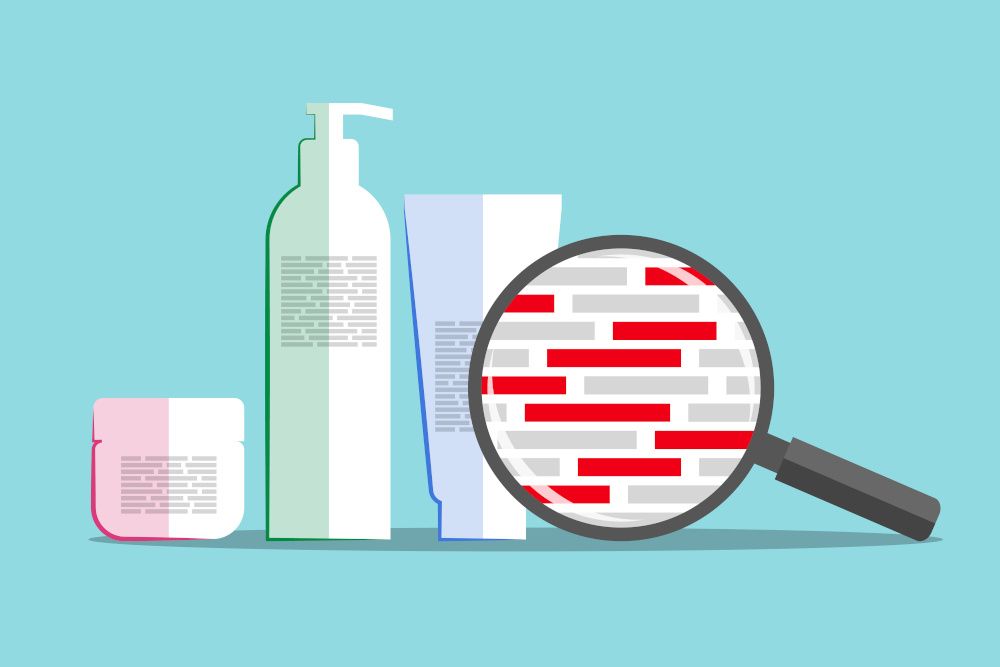According to Harvard Medical School, the average woman uses 12 different beauty products every day1—from face products like cleansers and makeup to body products like lotions, nail polish, and fragrances—and each of those products contains a wide range of ingredients, both natural and chemical. But while many people assume that beauty products on the shelf are tested and proven to be safe, that’s just not the case.
“Because cosmetics and personal care products are unregulated, the FDA is typically not aware of an ingredient unless a consumer complaint is made,” says Paula Simpson, BSc, RNCP, RH, nutricosmetics formulation and branding expert, nutritionist, herbalist, and author of Good Bacteria for Healthy Skin: Nurture Your Skin Microbiome with Pre- and Probiotics for Clear and Luminous Skin (Ulysses Press, 2019).
In fact, there are a number of ingredients that are banned in other countries and allowed on shelves in the U.S., including formaldehyde, parabens, PFOA, triclosan, and toluene. “A report by the Environmental Working Group in 20192 showed that the U.S. trailed behind many countries such as those in the European Union, Canada, Australia, and Japan on chemicals banned in cosmetics,” Simpson says. “Some countries have banned up to 1,400 chemicals, for example, but at the time of this report, the U.S. had only banned nine.”
For this reason, a growing number of health experts, natural beauty retailers, associations, and brands have taken it upon themselves to educate consumers about the potentially harmful effects of absorbing chemicals through the skin via various topical products. Most famously, perhaps, is the David Suzuki Foundation and the Environmental Working Group’s Cosmetic Database list of the “Dirty Dozen,” a list of potentially harmful ingredients in personal care products like skincare, haircare, deodorant, perfumes, and oral care products. The Environmental Working Group also published an updated list called the “Toxic 12,” which includes ingredients with potential endocrine and reproductive disruption effects, contaminant exposure that may dispose people to chronic diseases, and potential carcinogenic, nerve toxic, and skin irritant effects.
The EWG’s Toxic 12
- Formaldehyde
- Paraformaldehyde, a type of formaldehyde
- Methylene glycol, a type of formaldehyde
- Quaternium-15, which releases formaldehyde
- Mercury
- Dibutyl and diethylhexyl phthalates
- Isobutyl and isopropyl parabens
- The long-chain per- and polyfluoroalkyl substances known as PFAS
- M- and o-phenylenediamine, used in hair dyes
On the Radar
The 2019 documentary film “Toxic Beauty,” which proposed talcum powder to be a potential carcinogen, found footing even among mainstream consumers and caused a shift in how they shop for powders. New research may do the same for hair dye.
A recent study published in the International Journal of Cancer found a link between hair dye and breast cancer, showing that permanent dye use was associated with 45% higher breast cancer risk in Black women and 7% higher risk in white women with sisters who had a breast cancer diagnosis.3 According to the study authors, some hair care products contain more than 5,000 chemicals, including some known to disrupt the body’s natural hormone balance or to have cancer-causing effects in animals. “The combined growth in research and education is causing brands to become more transparent and potentially reformulate certain products for their customers’ health and beauty needs,” says Simpson.
Some alternatives, and potentially safer actives, include plant and herbal extracts, organic acids, enzyme/substrate systems, and antimicrobial peptides, she says. Along with looking for safer alternatives, Simpson suggests that consumers and brands seeking to reduce toxin exposure reduce the number of products used; look for organic, sustainable, or other certifications; and be aware of “greenwashing,” or the inclination for formulators to include one or two natural ingredients along with conventional chemical ones.
The good news? “Natural skincare and beauty products have been on the market for some time but, initially, these products didn’t work well or were more volatile,” Simpson says. “Now, with advancing formulation and manufacturing technologies, potentially healthier and non-irritant ingredients offer stronger efficacy with competitive shelf life and microbial protection to that of traditional formulations.”
References
- Harvard Health Publishing. Harvard Medical School. “Are Your Personal Care Products Putting Your Health at Risk?” Published April 1, 2020.
- Faber S. “On Cosmetics Safety, U.S. Trails More than 40 Nations.” Environmental Working Group website. Published March 20, 2019.
- Eberle CE et al. “Hair dye and chemical straightener use and breast cancer risk in a large US population of black and white women.” International Journal of Cancer, vol. 147, no. 2 (July 15, 2020): 383-391











